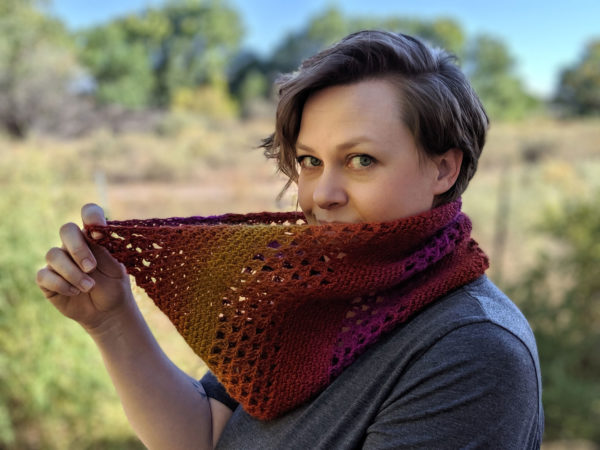
Based on the Mimic Shawl, the Mimic Cowl is a quick and cozy accessory to hook up. Perfect for gift giving or for keeping for yourself!
Click here to favorite, queue, and hook up a project page on Ravelry.
Details
Terminology: US
Skill Level: Intermediate (it can be a little tricky locating the ch1 sps on the ends. You’ll want to be fairly good at reading your stitches. Otherwise, it’s easy!)
Size: About 10″ wide and 28″ around
Yarn: Stylecraft Dreamcatcher, Apache (pictured above), 1 ball (about 90g/ used, about 285 yards)
Hook: 4mm
Gauge: 12 st and 12 rows is 2″ in moss stitch (gauge is not terribly important for this project)
Alterations
To change the width simply add or subtract multiples of 4 from the starting chain.
To change the length simply add or subtract sections of moss and V stitch. You can also make the moss and V stitch sections shorter or longer if you want. Tip: always make the sections shorter or longer by multiples of 2 rows to remain consistent with the pattern.
Pattern Notes
Check out the new “Print Friendly” button at the bottom of the page to print your own copy of the pattern.
If you need help or have any questions, scroll to the bottom of this page. There are links to where you can find lots of support.
This pattern is Copyright © 2019 Polly Plum. All rights reserved.
If you would like to share this pattern, please share the link to this webpage or the Ravelry pattern page (link below). Please do not distribute this pattern or the accompanying photos in any other form. Please read more in the Copyright section.
Abbreviations
- ch – chain
- dc – double crochet
- sc – single crochet
- sk – skip
- slst – slip stitch
- sp – space
- st – stitch
Special Stitches
V – dc, ch1, dc
Before you Begin
Just a couple things to be aware of before you start:
You will need to block the cowl before you join it. The edges of the cowl may curl (a lot) before you do. Please plan for this! See this post on steam blocking using blocking wires to get the best result, which is the technique I used to block my sample cowl that is pictured above.
You’ll want to keep the moss stitch sections loose. If they are too tight they will make the V stitch sections look saggy.
IMPORTANT! Except for the first and last stitches of the rows, you’ll always skip the stitches and work only into the chain spaces.
Pattern
Ch79. {Or, try over-chaining so you don’t have to worry about counting your chains!}
Row 1: Sc in 4th ch from hook {put a st marker in the loop created to make it easier to find on the next round.} [Ch1, sk next ch, sc in next ch] 37 times. Sc in last ch. Turn.
Row 2: Ch1, sc in first st, sk second st, sc in next ch1 sp, [ch1, sc in next ch1 sp] across to last st, ch1, sc in last st. Turn.
Row 3: Ch1, sc into first st, (ch1, sc in next ch1 sp) across to last ch1 sp, sk second to last st, sc in last st. Turn.
Rows 4 – 12: Repeat rows 2 and 3 four times more and row 2 once more.
Row 13: Ch4 and dc in first st {counts as first V stitch}, ch1, (sk next ch1 sp, V in next ch1 sp, ch1) across to last 2 ch1 sps, sk next ch1 sp, dc in next ch1 sp, sk next st, dc in the last st {this will be the starting ch3 from the previous row}. Turn.
Rows 14: Ch3 {counts as first dc}, dc in next ch1 sp, sk next ch1 sp, (ch1, V in next ch1 sp, sk next ch1 sp) across to last st {that means one ch1 sp will be unworked before the last st, just like in the triangle section}, ch1, V in third ch of the starting ch4 {the one that counted as the first dc of your first V}. Turn.
Rows 15 – 18: Repeat rows 13 and 14 two times more.
Moss Stitch Section:Repeat row 3 once, then repeat rows 2 and 3 five times more, then repeat row 2 one more.
V Stitch Section: Repeat rows 13 and 14 three times.
Continue in pattern until you’ve made 4 moss stitch sections and 4 V stitch sections. Your cowl will be a very slanty parallelogram.
{Or for a longer cowl, you can get 6 sections of moss/V stitch out of one ball of Dreamcatcher yarn.}
Block cowl before joining. To join, bring ends together making sure not to twist cowl (unless you want a mobius shape) and slst or sew together.

This post contains affiliate links. That means I get a small commission if you click on one of them and buy something at no extra cost to you, thereby helping me keep the lights and the patterns coming.
If you’d like to show your support and/or say thank you for this free pattern – the most helpful thing you can do is share a picture of your work on Ravelry or Facebook. Seriously! That’s it. If you liked the pattern, tell your friends and show them what you made.
If you’d like to see more of my work, visit the Patterns page here on Every Trick on the Hook or my Ravelry store.
The best way to keep up with my goings-on is to follow Every Trick on the Hook on Facebook. You can also message me there, post on the wall, and follow my posts for the latest news.
If you’re looking for a more interactive Facebook experience, join the Polly Plum Pattern Posse Facebook group. We’re a fun and supportive group. Really! There’s so much help there that chances are your question will be answered by someone before I even see it. It’s the best place to go with a question. It’s also a great place to share your Polly Plum makes and see what others are making.
If Facebook isn’t your thing you can also join the Ravelry group – Polly’s Place or follow @polly_plum_crochet on Instagram.
